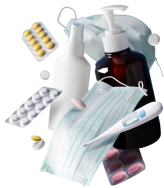Healthwire Pharmacy provides 100% genuine medicines straight to your doorstep.
Order Now! & Avail
Upto 10% OFF On All Your Pharmacy Orders!
Ceftriaxone 250mg
Healthwire Pharmacy Ratings & Reviews (1500+)
Product Information
Ceftriaxone 250mg injection is an antibiotic medication used to treat a wide range of bacterial infections. It belongs to the class of cephalosporin antibiotics and works by inhibiting the growth of bacteria, making it effective against various infections caused by susceptible organisms. This medication is commonly used to treat infections such as respiratory tract infections, urinary tract infections, skin and soft tissue infections, and gonorrhea. It is also used in the treatment of more severe infections like bacterial meningitis, sepsis, and bone or joint infections. Ceftriaxone is typically administered via injection, either intramuscularly or intravenously, and should be given under the supervision of a healthcare provider. It is important to follow the prescribed dosage and complete the full course of treatment to ensure the infection is fully resolved and to prevent antibiotic resistance.
Ceftriaxone 250mg
third-generation cephalosporin
injection
Following are the uses of Ceftriaxone 250mg Injection:
Dosage of Ceftriaxone 250mg Injection:
In case of an overdose of Ceftriaxone 250mg Injection, it is important to seek immediate medical attention. Symptoms of an overdose may include nausea, vomiting, diarrhea, and changes in liver or kidney function. Overdose can also lead to severe allergic reactions, such as swelling, difficulty breathing, or skin rashes. If an overdose is suspected, contact a healthcare provider or poison control center immediately. Treatment for an overdose typically involves supportive care, such as hydration and monitoring of vital signs. In some cases, adjustments to the dosage or discontinuation of the medication may be necessary. It is crucial to follow the prescribed dosage regimen and not exceed the recommended dose to prevent potential complications.
In case of a missed dose of Ceftriaxone 250mg Injection, contact your healthcare provider for guidance. Since this medication is typically administered in a clinical setting by a healthcare professional, missed doses are rare. If you were scheduled for an injection and missed it, your healthcare provider will determine the best course of action, which may involve rescheduling the injection or adjusting the treatment plan. Never attempt to administer the injection yourself. Always follow your healthcare provider's instructions and complete the full course of treatment to ensure the infection is fully treated.
Ceftriaxone 250mg Injection should be administered by a healthcare professional, either intramuscularly or intravenously, depending on the severity and location of the infection being treated. It is important to follow the prescribed dosage and administration schedule as directed by your healthcare provider. The injection is typically given in a medical setting, such as a hospital or clinic, under sterile conditions to reduce the risk of infection. If you are receiving the injection as part of an outpatient treatment plan, ensure you attend all scheduled appointments to receive the proper dosage. Always consult your healthcare provider if you have any concerns or questions regarding the administration of the medication.
When not to use Ceftriaxone 250mg Injection:
Side effects of Ceftriaxone 250mg Injection include:
Precautions and Warnings for Ceftriaxone 250mg Injection include:
Drug interactions of Ceftriaxone 250mg Injection include:
Food interactions of Ceftriaxone 250mg Injection include:
Ceftriaxone 250mg Injection should be stored in a cool, dry place, away from direct light and moisture. It should be kept at a temperature between 2°C and 8°C (36°F and 46°F), typically in a refrigerator. Do not freeze the injection. Ensure that the medication is stored in its original packaging to protect it from contamination and accidental exposure. Keep the injection out of the reach of children to prevent accidental ingestion or misuse. If the vial has been opened or the medication has expired, it should be disposed of properly, following local disposal guidelines or as advised by a healthcare provider. Never dispose of medication in household trash or sewage unless instructed to do so. Always consult a healthcare provider for appropriate disposal recommendations.
Quick Tips for using Ceftriaxone 250mg Injection:
Lab screening required for Ceftriaxone 250mg Injection:

Order Now! & Avail
Upto 10% OFF On All Your Pharmacy Orders!

If you face any issue, feel free to contact us. We provide 24/7 support to assist your problems